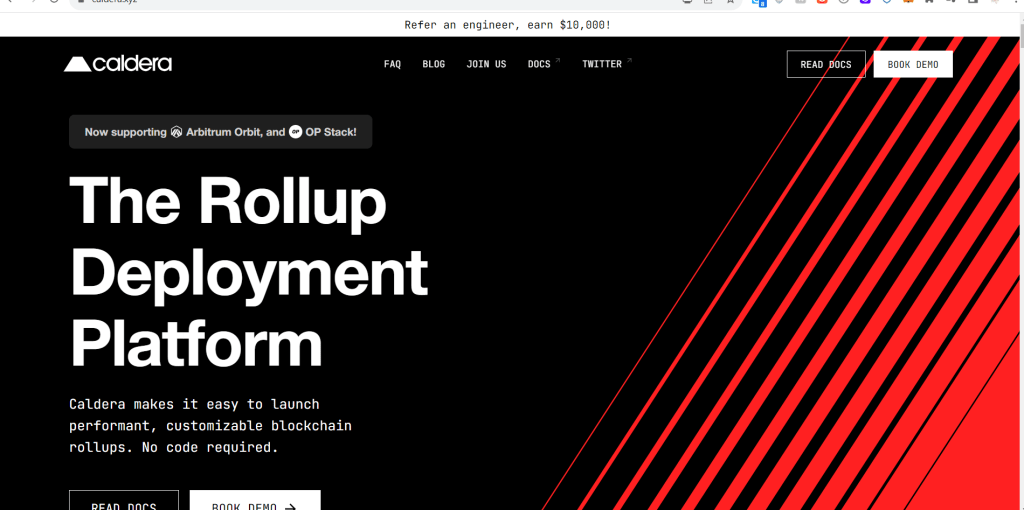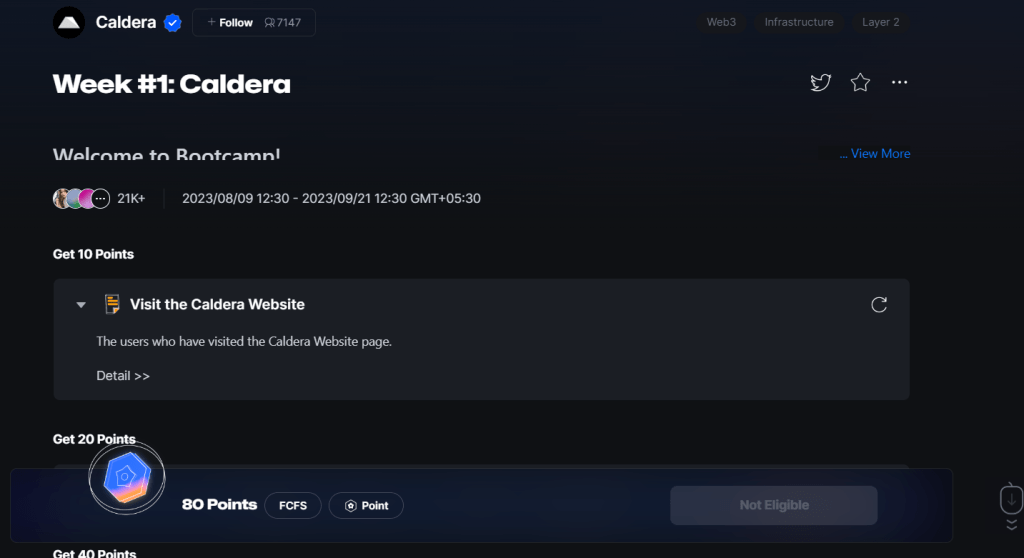Cost: 0$ Potential gain: XXXX$+ Don’t miss your chance Follow the Steps Below
What is Caldera?
Caldera allows anybody to create and manage dedicated, high-performance layer-two blockchain “rollups.” Rollup blockchains are small, highly customizable blockchains that inherit security from another blockchain, such as Ethereum or Polygon. Caldera provides each application its own “app-rollup,” offering them a dedicated lane for their app’s transactions, drastically decreasing transaction costs and allowing projects to de-risk from charge spikes and network disruptions.
However, app rollups are about more than just quick, low-cost transactions. App rollups enable developers to do so much more, such as:
- fee structures that can be customized, or the elimination of transaction fees entirely,
- earning project revenue through transactions, bridges, or MEV
- providing support for other programming languages
This is only the start. Web3 will outgrow its current set of blockchains, much as the internet is run on millions of servers throughout the world. Thousands more projects will choose to establish separate blockchains for their ecosystems as the sector grows, all driven by Caldera.
Check out their Website for More Info: https://caldera.xyz/

1. Now Coming to The Airdrops Steps You Guys don’t Need to Do Much Just Go to Their Galxe BootCamp And Follow, Visit their Page, and Answer some Quizzes, I will Provide the Quizzes Answer Below! – Galxe

Note: The Answers Are Bolded Options
Quiz: Basic Questions:
Question 1: What scalability framework does Caldera build on top of?
Question 2: In the context of rollups, what is a “batch”?
B. A group of transactions bundled together and processed in a single rollup, providing scalability by reducing the amount of data stored directly on the blockchain.
C. It’s a method of mining multiple cryptocurrencies simultaneously.
D. A “batch” in the context of rollups is when a group of bakers makes a large quantity of cinnamon rolls for blockchain enthusiasts.
Question 3: How do L2 rollups differ from L1 chains?
A. L2 rollups use a completely different consensus algorithm, while all L1 chains use Proof-of-Work
B. L2 rollups are always less secure than L1 chains because they don’t completely rely on blockchain technology
C. L2 rollups can only process a fraction of the transactions that L1 chains can.
D. L2 rollups process a batch of transactions off the main chain (L1) to reduce congestion and improve scalability, while L1 chains process all transactions directly on-chain.
Question 4: What’s the difference between Optimistic vs. Zero-Knowledge Rollups?
A. Optimistic Rollups are naturally upbeat and positive, while Zero-Knowledge Rollups don’t know anything at all
B. Optimistic Rollups require fraud proofs for validation, while Zero-Knowledge require a trusted setup and zk-SNARKs for validation which can be slower due to the complexity of their cryptographic proofs.
C. Optimistic Rollups use a completely different blockchain for transaction verification, while Zero-Knowledge Rollups rely solely on the Ethereum mainnet.
D. Optimistic Rollups and Zero-Knowledge Rollups do not have any major differences; they are two names for the same scaling solution
Question 5: Which of the following is TRUE about monolithic, public blockchains?
A. They’re highly customizable
B. More security than modular appchains
C. As more users onboard, transaction fees increase and efficiency slows
D. They provide more robust developer-tooling
Question 6: How do Caldera chains improve on the monolithic blockchain model?
B. Sub-second transaction confirmation times
C. High customizability across the stack
Question 7: What core service does Caldera provide?
A. Suite of consumer-facing APIs, SDKs and tools to build and scale your app with ease
B. Deploying high-performance, customizable app-specific L2 app-specific rollups.
C. Scalable, high-throughput EVM-compatible L1 chain
D. A cross-chain NFT liquidity protocol
Question 8: Where exactly does Caldera offer customizations?
Question 9: What additional feature(s) do Caldera chains offer?
Question 10: What is a settlement layer?
A. It’s the physical layer of hardware devices that mine cryptocurrencies.
B. It’s the foundational layer of a blockchain where transactions are finalized and securely recorded.
C. It’s the layer in the blockchain network that deals with network connectivity and data transmission.
D. It’s a special kind of blockchain designed exclusively for settling large international transactions.
Question 11: What is a Data Availability (DA) layer?
A. It’s a software layer that translates data into a format that can be read by blockchain nodes.
B. It’s a separate network of nodes dedicated to verifying the availability of data on a blockchain.
C. It’s a layer in the blockchain protocol designed to ensure that block data is available to all participants, even if only a subset of participants store the full blockchain.
D. It’s a hardware component of blockchain nodes, responsible for storing transaction data.
Now Advanced Question:
Question 1: What is an advantage of Caldera’s EVM-compatibility?
A. Allows developers and users to interact with the blockchain and perform various actions, such as sending transactions, querying account balances, and more
B. Provides compatibility with existing client libraries, such as Ethers.js, Web3.js, Web3.py and go’s web3 library
Question 2: What programming tools & frameworks are compatible with Caldera?
Question 3: What rollup stacks are Caldera currently compatible with?
A. Only Optimism’s OP Stack
B. OP Stack AND Arbitrum Orbit
Question 4: True or False: Caldera chains offer custom precompiles?
Question 5: What types of applications can be built with Caldera chains?
B. Decentralized exchanges, and other defi protocols
C. Institutional applications
Question 6: What’s the goal of the built-in bridge on Caldera chains?
A. Enable token staking on Caldera chain
B. Make it easy for developers and users to move assets and data between the Caldera chain and its corresponding layer-one blockchain
C. Help users cross over from Web2 to Web3
D. Connect crypto chains to the internet, allowing them to access online data
Question 7: What is an Oracle?
A. A third-party information source that supplies data to blockchains that cannot obtain it themselves, allowing smart contracts to interact with data outside their network.
B. A hardware wallet that protects your crypto assets using prophetic algorithms.
C. An individual or organization with a deep understanding and insight into the workings of the crypto market, often consulted for advice.
D. It’s a high-powered computer used to mine cryptocurrencies more efficiently.
Question 8: What token is typically used for gas fee payment on any given chain?
A. The token with the highest value on the given chain.
B. Usually the native token of the given chain (e.g., Ether for Ethereum)
C. The one that the transaction sender chooses
D. The one with the most liquidity on the given chain
Question 9: What tokens do Caldera chains allow for gas fee payments?
A. Any ERC-20 of the developer’s choice
D. The token native to the chain’s settlement layer
Question 10: Which of the following is the biggest advantage of custom gas fee tokens?
A. They can enhance economic alignment between the application and its users, as they allow the app’s native token to be used for transaction fees instead of the blockchain’s native token
B. They allow users to mine new cryptocurrencies at a faster rate
C. It simplifies the user experience but also eliminates the need for users to hold multiple currencies
Question 11: True or False: I want to build an app on Caldera!
That’s it Let me know if you have any questions or confusion in the comment or DM on my Twitter account
@GLCrytpoAirdropThanks for sticking till the end For more Such Airdrops Checkout- Crypto Airdrops 






